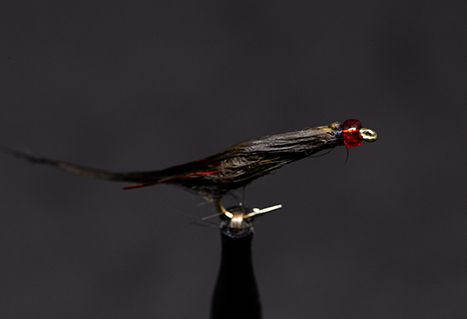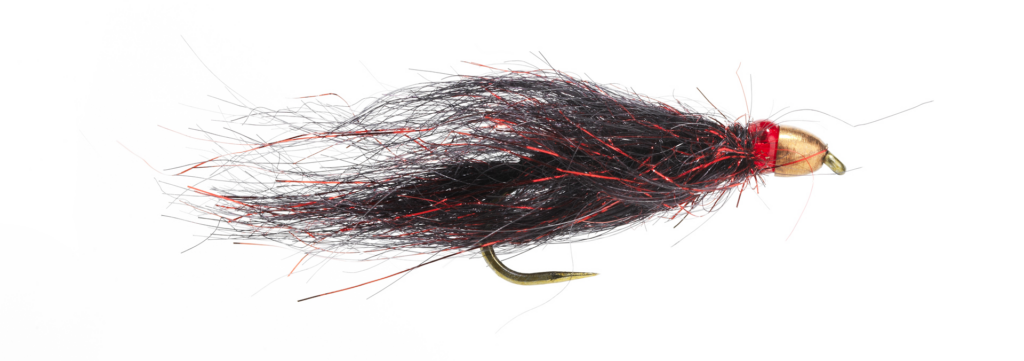I still remember that day on Plateau Lake, located northeast of Merritt, almost 25 years ago when my fly fishing partner and I learned a lot about leeches. It was early June and we had been having fairly good success that morning on chironomid pupal patterns fished on long leaders and floating fly lines. By noon the chironomids quit emerging in the shallow water so we moved out into deeper water in the hopes of finding an afternoon hatch. We soon found chironomids emerging in about nine metres of water so dropped anchors and switched to sinking lines.
Over the next two hours a few more fish were fooled by our pupal patterns. By 3 o’clock it looked like we were finished for the day. It was agreed we would leave after the next fish.
Well, we would have left if that last fish hadn’t spit out a couple of leeches while thrashing around the landing net. The still live leeches were mottled black and brown in colour. I put on a black seals fur leech and Don tied on the identical fly except tied with brown seals fur. We were both fishing slow sinking flylines and retrieving with very slow hand twists. I hooked a fish on my first cast and continued to get strikes about every other cast. After I landed several fish Don switched to the black seals fur leech but still did not get any strikes.
We then compared flies which were identical except my pattern was one size smaller. As soon as Don changed to the small fly he was instantly into fish. Checking the stomach of any fish you keep will provide useful feeding information. In this case the four fish we cleaned had a stomach full of chironomid pupa and one to three leeches as “dessert”. A throat pump can also be used to sample the esophagus of a fish you intend to release alive.
Since that day I have seen this lunch and dessert combo many times and make it a habit to fish leeches after a chironomid hatch begins to wane for the day. That day also taught us how selective trout can be about size and colour even when feeding on bigger food items.
Leech Biology and Lifecycle
Leeches belong to the Phylum Annelida which includes earthworms and marine worms. The most noticeable difference between leeches and other annelid worms is their dorso-ventral flattened shape, that is, flattened top to bottom. Leeches also have suckers at either end of their bodies. They typically swim in a slow up and down undulating motion but when agitated can move at a much faster pace.
Contrary to popular belief the vast majority of leech species in North America are not blood suckers but are omnivorous. They feed on a variety of food sources including insects, freshwater shrimp, decomposing vegetation and carrion. When fully extended big leeches can reach over 25 cm in length.
Most common sizes range from 3 to 7 cm long. Colouration varies considerably with the most prominent colours being mottled brown and green, black and brown, maroon and various shades of green. The underside of a leech is typically lighter in colour than the backside.
Leeches are most often found living near the bottom of the lake in water less than 8 metres deep. This is because their preferred food sources are found amongst the vegetation associated with areas of the lake that receive the greatest amount of sunlight.


Leeches have a unique reproductive life cycle. They are hermaphroditic. Each individual carries both male and female reproductive organs. This allows a leech to reproduce by itself but more commonly a pair will mate with both partners developing fertilized egg masses. Egg clusters are commonly attached to bottom debris, rocks, or buried in the lake bottom substrate. Most mating occurs during the spring months. Some species of leeches are known to live in excess of 10 years.
Fishing Strategies
Leeches are available as a trout food source throughout the year. This is why leeches are known as good searching patterns. They are always a good choice when exploring a new lake or fishing during non-hatch periods. However, there are certain times when fish will feed on them more intensely. The spring period which coincides with the most intense chironomid hatches is an excellent time to be tying leeches.
At this time of the year leeches may be found swimming at all depths. Try fishing patterns close to the bottom first then gradually move up the water column. Use a moderately slow hand twist retrieve to imitate the natural undulating motion. Fast sinking (type II), slow sinking (type I), intermediate sinking and floating lines are all good choices for imitating leeches at various depth levels.
Remember to keep an eye out for real leeches swimming by to give you an indication of actual colour and size in the lake.
Fishing Leeches at Night
Another good time to fish leeches is at night during the hot summer months. At this time of the year, during daylight hours, the shallower shoal water is often too warm for trout to comfortably feed in. Fish will sit in the deeper water just above the thermocline. The thermocline is described as that depth zone of water where the heat from the sun no longer penetrates and thus the water remains quite cool but still well oxygenated. In most small lakes the thermocline establishes between 6 and 8 metres deep. At night the shallower water cools enough for fish, and often big ones come onto the shoals to feed.
Leeches are big food items and often sought out by these nocturnally feeding trout. Fishing tactics change when night fishing. A floating flyline and a 4 metre long leader ending with 3 to 3.5 kilogram tippet is standard equipment. The heavier tippet material is required to cast big leech patterns and provide better odds in landing big fish. In most of these situations you will be anchoring in less than 3 metres of water casting towards bulrush or cattail patches.
Trout will cruise along the edges of these emergent vegetation patches in search of big food items such as leeches. Cast your leech pattern, wait for the fly to sink close to the bottom and then begin a moderately fast strip or hand twist retrieve. Woolly Bugger and Matuka patterns are good night leech imitations as they offer a pulsating action when pulled through the water. Be sure to try bead-headed patterns as the added weight will add more undulating action to the fly during the retrieve. Trout can detect the added motion of the fly and hone in on these imitations despite the extremely low light conditions.
Be extra careful when retrieving your flyline into the boat or float tube when night fishing. You want to ensure there are no tangles in the flyline when that really big fish hits and starts for the other end of the lake.
Fishing Leeches During Late Fall
The late fall season is also an excellent time to fish productive lakes. The major insect hatches are long gone so overwintering food sources such as shrimp, dragonfly nymphs, caddis larvae and leeches are actively sought out by trout.
The shallow water or shoal areas of the lakes again become the major feeding area at this time of year. Leeches can be effectively fished on slow sinking, intermediate sinking and floating fly lines. First try fishing your leech patterns close to the bottom of the shoal then work higher in the water column. Start out by retrieving the leech pattern slowly and if unsuccessful gradually speed up the retrieve.
Late fall fishing is certainly a good time of the year to hook a really big trout. Make sure that your fly hooks are sharp so that they can penetrate the tough cartilage mouth parts of those really big fish.
Most ardent stillwater fly fishers have created their own proven leech patterns; however, there are also numerous commercially tied designs that also fool trout.
Leech Patterns
Some of the more effective leech patterns are tied using materials such as dyed marabou feathers, mohair, seals fur, rabbit strips, sparkle chenilles and saddle hackles. Proven leech patterns have several common features:
- soft in design and appearance so that they look alive when retrieved through the water
- tied in one solid colour or in natural colour combinations i.e. Black, brown, maroon, green or brown and black, brown and green, black and maroon
- tied in a variety of sizes for selective trout
- beads or cone heads will add more action to the retrieved fly
Stillwater fly fishers should have a good selection of leech patterns in their fly box.
They are readily available and as we know, trout certainly will key in on them as the main meal or “dessert” at specific times of the year.


Author: Brian Chan, Fishing Advisor, Freshwater Fisheries Society of BC
